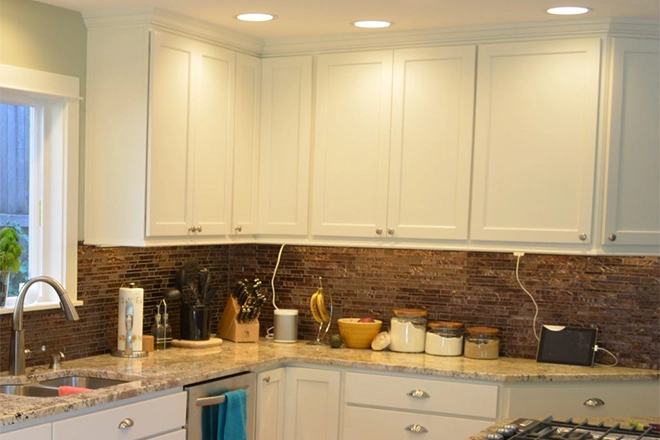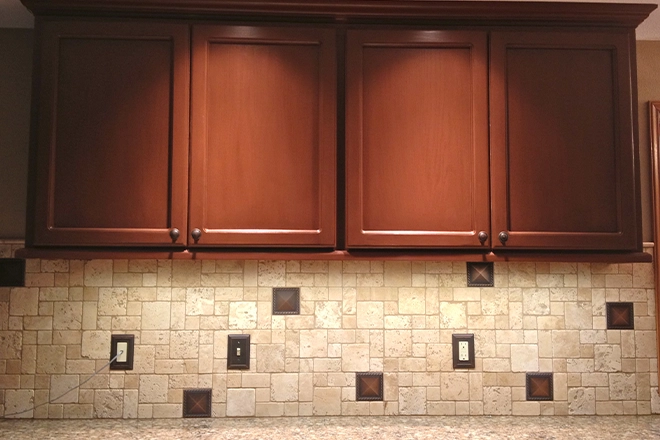Wired for Wow

Tired of clunky outlets ruining your beautiful backsplash? Want smart ways to hide outlets without giving up convenience?
In this post, you’ll learn clever kitchen outlet ideas that blend function and design, from hidden power options to USB-ready upgrades.
By the end, you’ll know how to make your kitchen outlets safer, sleeker, and way more useful after your kitchen remodel.
Key Points
- Hidden outlets are a game-changer. Pop-up, under-counter, and in-drawer outlets keep your kitchen surfaces clean and uncluttered without losing power access.
- Aesthetic placement matters. Strategic outlet locations and color-matched covers can make your power sources nearly invisible and blend with your kitchen design.
- Smart features boost daily function. USB ports, GFCI protection, and voice-controlled outlets add modern convenience while keeping things code-compliant and safe.
Best Kitchen Outlet Ideas at a Glance

Here are some of the most popular and effective kitchen outlet ideas you can use:
- Pop-up outlets that stay hidden when not in use.
- Undermount outlets installed beneath counters or cabinets.
- In-drawer outlets for discreet charging and appliance storage.
- USB and combo USB/GFCI outlets for smart home compatibility.
- Recessed and flush-mount outlets that sit neatly within surfaces.
- Outlet strips under cabinets or counter lips to avoid wall clutter.
- Faux cabinet panel outlets that maintain seamless cabinetry appearance.
- Pendant outlets suspended above islands for overhead access.
- Color-matched and paintable outlets that visually blend into surfaces.
Contact us today about your kitchen remodel.
14 Kitchen Outlet Ideas That Can Change the Face of Your Kitchen
1. Pop-Up Outlets
Pop-up outlets are sleek, retractable units that stay hidden in your kitchen counter or kitchen island until you need them.
Many include USB ports and GFCI protection, making them perfect for both tech and safety.
Some models even include wireless charging pads, smart home integration, or LED lights for nighttime use.
There are motorized versions as well.
2. Undermount Outlets
Undermount outlets tuck under overhangs or the underside of upper cabinets.
They’re one of the best ways to hide outlets from plain sight while keeping them easily accessible.
This is a go-to choice if you want to avoid disrupting a tile backsplash.
3. In-Drawer Outlets
Adding outlets inside a drawer gives you a private charging station or a tucked-away power source for things like a coffee pot or blender.
This solution keeps cables out of view and prevents crowding on the kitchen counter. It also works well in a kitchen remodel when you’re building custom cabinetry.
4. Recessed and Flush-Mount Outlets
Recessed outlets sit deeper into the wall so plugs don’t stick out.
They’re useful behind appliances or in narrow spaces between cabinetry and walls.
Flush-mount models are designed to sit almost level with surfaces, ideal for keeping a clean kitchen aesthetic.
5. Camouflaged and Color-Matched Outlets
One of the most clever ways to hide outlets is by using outlet covers that match your backsplash, paint, or tile.
Some are even made with a faux finish or painted to match kitchen cabinets or surrounding wall surfaces. This trick helps the outlets disappear into the overall kitchen design.
Speaking of camouflaged outlets, there are wireless charging stations that can be built into your countertops. No plugs, no cords, all style.
6. Strategic Outlet Placement
Placing outlets horizontally instead of vertically makes them blend in better along the back wall or under cabinetry.
Positioning outlets where appliances are most often used can also reduce cord mess.
Outlet placement should always follow local building codes, even when aiming for low-visibility designs.
7. Faux Cabinet Panels and Decorative Covers
If you’re working with a kitchen island or unique cabinetry, you can disguise cabinet outlets behind a false drawer front or a hinged door panel.
These hide outlets while still offering convenient access when needed. Decorative covers can also help outlets match hardware finishes like brass or stainless steel.
8. Embrace the Look
Not every outlet needs to be hidden.
If you have a modern or industrial kitchen design, you can lean into the look with metallic, black, or textured cover plates. These can become intentional details instead of visual clutter.
9. USB and Combo Charging Outlets
USB-enabled kitchen outlets let you plug your phone or tablet directly into the wall without a blocky adapter.
Some versions come with both USB-A and USB-C for faster, future-ready charging.
They’re great for charging devices while you prep dinner or look up recipes.
10. Smart Outlets
Smart outlets can be controlled by voice, apps, or timers.
You can schedule your coffee pot to start brewing in the morning or turn off appliances remotely.
11. Safety and GFCI Protection
Always use GFCI-rated outlets near sinks or any water sources.
Many outlet ideas look sleek, but safety still matters. Combo models with GFCI and USB help cover both bases in one install.
Kitchen Island Outlet Ideas
12. Built-In Cabinet Outlets
Designing cabinet outlets into your kitchen island gives you safe, handy access to power without ruining the look.
You can install two outlets or more inside a flip-up panel, behind a cabinet door, or along the side of the cabinetry.
13. Under-Overhang Outlet Strips
Mounting an outlet strip beneath the overhang of a bar-height counter is one of the easiest ways to add power without visual bulk.
It’s a smart solution for plugging in a toaster, coffee maker, or small appliances without leaving them out on the counter.
14. Pendant or Drop-Down Outlets
For open concept spaces with limited wall access, pendant outlets hang from the ceiling or drop from under shelving.
These are adjustable and easy to reach, and they don’t take up any counter space. Use them for task lighting or to power temporary devices.
What other kitchen amenities can you have?
Installation and Code Considerations
Code Compliance
Kitchen outlets must follow specific rules about spacing, height, and proximity to water.
GFCI outlets are required near the sink or any wet zone.
Check local building codes or talk to a licensed electrician before you install.
Retrofitting Into Existing Kitchens
You don’t need a full kitchen remodel to update your outlets.
Outlet strips, pop-up outlets, and in-drawer solutions can often be added to existing layouts with minimal disruption.
Retrofitting costs depend on wiring access, cabinetry, and surface materials.
Installation Costs
Installing new kitchen outlets can range from $100 to over $500, depending on the type.
Pop-up outlets and smart features are more expensive but offer long-term value.
Always get a quote from a pro if you’re adding outlets to a kitchen island or cutting into finished counters.
FAQs About Kitchen Outlets
What is the rule for kitchen outlets?
The rule for kitchen outlets requires that no point along the wall line be more than 24 inches from a receptacle. Countertop spaces 12 inches or wider must have outlets. This ensures accessibility for small appliances and complies with National Electrical Code safety standards.
What kind of outlet should be in a kitchen?
Kitchens must use Ground Fault Circuit Interrupter (GFCI) outlets. These outlets shut off power when they detect electrical imbalances, reducing shock risk. GFCI protection is required for outlets serving countertops and any outlet within 6 feet of a sink, including for appliances like dishwashers and disposals.
Should all outlets in the kitchen be GFCI?
Yes, all kitchen outlets must have GFCI protection under the 2023 National Electrical Code. This includes outlets for kitchen countertops, refrigerators, microwaves, and dishwashers. GFCI protection can be provided through GFCI receptacles or breakers and is essential for preventing electric shock in wet environments.
Plug Into Better Design With Home Run Solutions
From hidden outlets to smart upgrades, Home Run Solutions can help bring power, convenience, and clean design to your kitchen remodel. Whether you’re updating a single space or revamping the entire layout, we know how to combine modern kitchen outlet ideas with code-safe installations that actually work.
If you’re ready to upgrade your kitchen outlets and bring smart function into your everyday cooking space, fill out our contact form today or give us a call. We’ll help you plan a kitchen that looks sharp and works smart.
